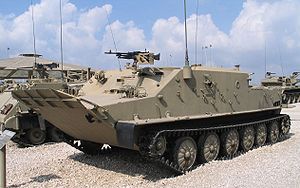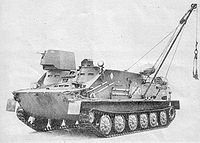| Revision as of 19:53, 11 June 2007 editGon4z (talk | contribs)1,299 editsm →Variants← Previous edit | Revision as of 20:20, 11 June 2007 edit undoGon4z (talk | contribs)1,299 editsm Bluewings STOP vandalising, Albania is a vert well known user of the BTR-250 & Type 77 stop vadalising look at the links on the Type 77 article i have createdNext edit → | ||
| Line 57: | Line 57: | ||
| ==Operators== | ==Operators== | ||
| ], ], ], ], ], ], ], ], ], ], ], ], ], ], ], ], ], ], ]/], ], ], ], ], ]. | ], ] ], ], ], ], ], ], ], ], ], ], ], ], ], ], ], ], ], ]/], ], ], ], ], ]. | ||
| ==External links== | ==External links== | ||
Revision as of 20:20, 11 June 2007
Weapon| BTR-50 | |
|---|---|
 BTR-50PK in Yad la-Shiryon museum, Israel. BTR-50PK in Yad la-Shiryon museum, Israel. | |
| Specifications | |
| Mass | 14.5 t |
| Length | 7.07 m |
| Width | 3.14 m |
| Height | 2.03 m |
| Crew | 2+20 |
| Armor | 6-13 mm |
| Main armament | none or 7.62 mm SGMB machine gun or 14.5 mm KPV machine gun. |
| Engine | V-6 diesel 240 hp (177 kW) |
| Power/weight | 16.6 hp/tonne |
| Suspension | torsion bar |
| Operational range | 240 km |
| Maximum speed | 44 km/h |
The BTR-50 was a Soviet amphibious armoured personnel carrier based on the PT-76 tank chassis. The BTR-50 was tracked, unlike all other members of the BTR series, which were wheeled.
History and description
The BTR-50 was a Soviet amphibious armoured personnel carrier. The vehicle, based on the PT-76 amphibious tank chassis, was developed in 1952 and entered service with the Soviet Army in 1954. BTR stands for Bronetransporter (БТР, Бронетранспортер, literally "armoured transporter") †.
Like the PT-76, the BTR-50 has flat, boat-shaped hull, and ready to swim after merely erecting the trim vane on the bow. In water it is propelled by two hydrojets, one in each side of the hull, with the exits at the rear of the hull. The rear exits have lids that can be fully or partially closed, redirecting the water stream to the forward-directed exits at the sides of the hull, thus enabling the vehicle to turn or float reverse.
Employment history
APCs of the BTR-50 series served in motorized rifle regiments of tank divisions in the Soviet and East German armies. Command vehicle variants were employed by many Warsaw Pact armies. Finnish Defence Forces still employ the BTR-50 as a communication vehicle used within the latest digital field communication network.
The BTR-50 and its Czech/Polish clone OT-62/TOPAS were used by Egypt and Syria in the Six-Day War (1967). Some vehicles were captured and commissioned by the Israel Defense Forces, so in the Yom Kippur War (1973) the BTR-50 was employed by both sides. Some of the Israeli BTR-50s were later transferred to the South Lebanon Army.

Variants
- BTR-50P (1952) - the first version. Open-topped crew compartment, no integral weapons.
- BTR-50PA (1954) - a 14.5 mm KPV machine gun mounted on the roof of the commander's cupola.
- BTR-50PK (1958) - fitted with an armored roof and armed with a 7.62 mm SGMB machine gun.
- BTR-50PU (1959) - a command vehicle. Carries crew of 10. Isn't armed. Has an armoured roof with oval hatches. Most of the BTR-50PU have two projecting bays on the front of the vehicle instead of one.

- BTR-50PUM-1 (1972) - a command vehicle with a crew of up to 8, an upgrade of the BTR-50PU.
- BTR-50PK(B) - armored recovery vehicle.
- MTP - technical support vehicle.
- MTK - mine-clearing vehicle equipped with launcher that fires tubes filled with explosive.
- Obiekt 914 - experimental IFV.
- BTR-50PK (Yugoimport SDPR upgrade) (2005) - upgrade package for the BTR-50PK offered by the Serbian defense firm Yugoimport SPDR. The package adds a turret (from the Yugoslav M-80 APC), a 30 mm cannon, a 7.62 mm Zastava M86 machine gun, four smoke grenade launchers and two AT-3 Sagger anti-tank missiles.
- OT-62 A/B/C (TOPAS) - a closely related Czech/Polish APC. Has two projecting bays on the front of the vehicle (like the BTR-50PU) and side doors.

- WPT-TOPAS - a Czech/Polish ARV based on the OT-62.

- Type 77 Amphibious Armoured Vehicle - a Chinese vehicle based on the Type 63 amphibious tank which in turn is a derivative of the PT-76. Although not a clone of the BTR-50, the Type 77 has similar hull shape and layout.
- Type 77-1 - amphibious armoured personnel/artillery carrier designed to carry a disassembled gun (85 mm towed anti-tank gun or 120 mm towed howitzer) on the roof. The vehicle has hydraulic winch and ramps to load/unload the gun.
- Type 77-2 - amphibious armoured personnel carrier. No winch and ramps.
Operators
Afghanistan, Albania Algeria, Congo, Czechoslovakia, East Germany, Egypt, Finland, Guinea, Hungary, Indonesia, Iran, Iraq, Israel, Nicaragua, Poland, Romania, Serbia, Slovakia, Soviet Union/Russia, Somalia, Syria, Vietnam, South Lebanon Army, Zimbabwe.
External links
- FAS.org
- Template:Fr icon Armyrecognition.com
- Template:Ru icon Armoured.vif2.ru
- Communication system of a formation at the Finnish Defence Forces website
- OT-62 / TOPAS at Globalsecurity.org
- Type 77 APC at Sinodefence.com
| Soviet and Russian armoured fighting vehicles after World War II | |||||||||
|---|---|---|---|---|---|---|---|---|---|
| |||||||||
| |||||||||
| |||||||||
| |||||||||
| |||||||||